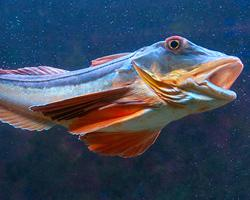
Greutăți și măsuri
| Lungime | de la 25 la 75 cm |
|---|
Starea de conservare
| Amenințat |
Descrierea animalului
The Tub Gurnard, scientifically known as Chelidonichthys lucerna, is a fascinating species of marine fish that belongs to the family Triglidae, commonly known as sea robins or gurnards. This species is notable for its distinctive appearance and behavior, making it a subject of interest among marine biologists and enthusiasts alike.Physically, the Tub Gurnard is characterized by its elongated, somewhat flattened body, which can reach up to 75 centimeters in length, although the average size is typically around 30 to 50 centimeters. The skin is covered in small, hard scales that give it a rough texture. One of the most striking features of this fish is its broad, bony head, which is equipped with a set of strong, armored plates. The mouth is large and positioned at the front of the head, enabling it to prey on a variety of marine organisms.
The coloration of the Tub Gurnard is another remarkable aspect, displaying a vibrant palette that can include shades of red, orange, pink, and even blue, often with intricate patterns that serve as camouflage against the seabed. The pectoral fins are especially noteworthy; they are large and wing-like, with the first three rays of each fin being separate and elongated, resembling fingers. These "fingers" are used for walking along the ocean floor and for sensing prey hidden in the sand or mud.
The dorsal fin of the Tub Gurnard is divided into two parts: a shorter, spiny section at the front, followed by a longer, softer section. The anal and pelvic fins are relatively small, while the caudal (tail) fin is fan-shaped, aiding in swift movement through the water.
Tub Gurnards inhabit a wide range of marine environments, from shallow coastal waters to depths of several hundred meters. They are predominantly found in the eastern Atlantic Ocean, from Norway and the British Isles all the way down to Senegal, including the Mediterranean and Black Seas. Their habitat preferences include sandy, muddy, or gravelly seabeds, where they hunt for food.
The diet of the Tub Gurnard consists mainly of small fish, crustaceans, and cephalopods. They are opportunistic feeders, using their modified pectoral fin rays to detect and unearth prey from the substrate.
Reproduction in Tub Gurnards involves the release of eggs and sperm into the water column, where fertilization occurs externally. The larvae are planktonic, drifting with ocean currents until they are large enough to settle on the seabed.
Despite their striking appearance and interesting behaviors, Tub Gurnards are not considered to be at significant risk of overfishing or habitat loss at present. They are sometimes caught as bycatch in trawl fisheries but are also targeted in some areas for their firm, white flesh, which is considered a delicacy.
In summary, the Tub Gurnard is a unique and captivating species within the marine ecosystem, distinguished by its armored head, vivid coloration, and the remarkable ability to "walk" along the ocean floor. Its presence in a wide range of marine habitats and its role in the food web underscore the diversity and complexity of life beneath the waves.
Fotografii noi cu animale
Top 10 animale
- Dolphin gull (Leucophaeus scoresbii)
- Diana monkey (Cercopithecus diana)
- Moustached guenon (Cercopithecus cephus)
- Galápagos tortoise (Geochelone nigra complex)
- Greek tortoise (Testudo graeca)
- Stone loach (Barbatula barbatula)
- Japanese macaque (Macaca fuscata)
- Russian tortoise (Testudo horsfieldii)
- Common flying dragon (Draco volans)
- Galápagos penguin (Spheniscus mendiculus)